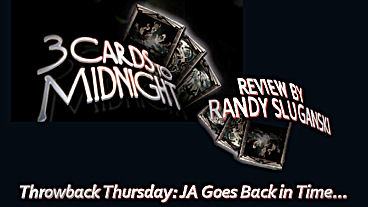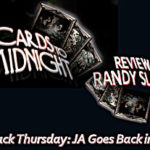
Throwback Thursday – Three Cards to Midnight






Note: This review was originally published May 12, 2009
Hey, remember Aaron Connors and Chris Jones? They are the creative team responsible for some private investigator character name of Tex Murphy who starred in games like Under a Killing Moon, Overseer and The Pandora Directive. Yeah, I know it’s been a long time, but they have finally got their act together, got their mind off of golf and developed their first new game since…well, longer than I care to remember.
Now, before you geriatric adventurers out there – and I’m one of them – tinkle in your Depends, both Tex and his fedora are still in retirement. Taking a page from Jane Jensen’s notebook (Inspector Parker,Women’s Murder Club) Aaron and Chris have taken a stab at advancing the casual game genre beyond its simplistic roots to the point where we now have not only puzzles and plot, but also animation and voice-acting. Can anyone say adventure game in disguise?
Those of you who still read the phrase ‘casual game’ and immediately picture variations of Tetris or Scavenger Hunt, your confusion is understandable and to be fair, maybe it is time that the developers of games such as Three Cards to Midnight and Women’s Murder Club agreed on a new genre designation so that their product can be differentiated from the more simplistic offerings. For as you’re about to learn, TCM is much more advanced and anything but a casual game.
Three Cards to Midnight (TCM) is being billed by its developers as a psychological thriller. The story centers around Jess Silloway, a young woman who upon the eve of celebrating her thirtieth birthday, awakens to find herself in a room with a strange man. She has no recollection of the past few days and the man explains to Jess that he is there to help her remember and then lays out a series of Tarot cards that are meant to trigger memories from Jess’ subconscious.
The mystery gradually unfolds over the course of eight chapters, each of which is similar in concept. The story was influenced by The Twilight Zone television series both in tone and execution (In fact, if one looks closely, one might find a few references to The Twilight Zone in some of the scenes). As each chapter begins, Jess is asked to choose between three Tarot cards. Each Tarot card is meant to trigger a memory of a person or location of significance to an event from Jess’ past. All three Tarot cards must be chosen in each chapter so that the order in which they are chosen is not important.
Once a card has been chosen, Jess will speak aloud a series of one to four keywords that she associates with that card. We are then taken to a location from Jess’ memory, such as a room in her apartment or aboard her parent’s boat, where objects must be found that connect to the keywords. Once all of the objects have been found, a flashback is triggered that unlocks a key point of the story and there are as many as twelve animated flashbacks per chapter.
Now lest you think this is but a simple game of searching for and then highlighting an object, it is anything but and often requires much thought. When a keyword appears at the bottom of the screen, it may have five blank squares to the left and three blank squares to the right. So if the keyword is ‘light’, then you must find objects on the screen that, when combined with the keyword, create a new word. So, for example, if there is a doll house in the room, when clicked on it would create the back-word ‘lighthouse’. A painting on the wall of a nighttime scene with a crescent moon would create the front-word ‘moonlight’. As the game progresses, the associations become more difficult and thought-provoking. Depending on the level of difficulty chosen to begin the game – Easy, Challenge or Gamer – you are allocated a pre-determined amount of incorrect picks per room and also a limited number of clues before the area resets. Each chapter also has between one and three puzzles, the type of which can be found in any adventure game such as cryptograms and sliders.
Great care has been taken to provide both a back-story and depth to the character. The music is appropriately eerie and the voice-actors excellent. The animated flashbacks and present-day scenes in the game are the final link that elevate TCM above casual status.
TCM is intriguing both in its approach and execution and can be very addictive. But honestly, it would be a huge disappointment if developers with the pedigrees of Connors and Jones were to offer anything of lesser quality.
Three Cards to Midnight is currently only available as a pc download from the Big Finish website at a cost of $20. Aaron and Chris are considering the possibility of releasing a special boxed edition of the game if there would be such a demand from the fanbase (and you all know how much we adventure gamers love our boxes!).

Leave a Reply